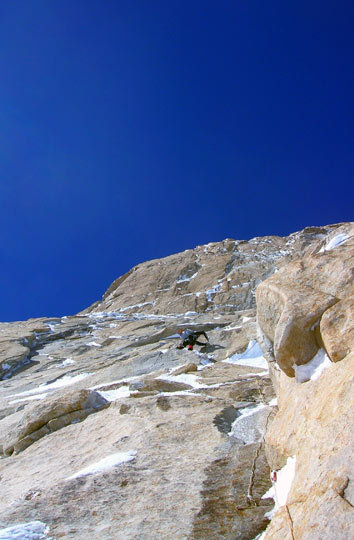
Latok III’s South West Ridge. [Photo] Roch Malnuit
On August 26, after a twelve-hour flight, Julien Herry and I arrived in Islamabad. Our plan was to fly to Skardu–the last big town before entering those deep valleys of the Karakoram–on the same day. Weather held us back, and on August 29 we took two jeeps to Askole, at the base of the Baltoro and Biafo glaciers, intent on making the fourth ascent–and second in alpine style–of Latok III (6949m).

Roch Malnuit on the second day of climbing. The duo’s bivy site was just below and behind Roch on the ridge. [Photo] Julien Herry
Latok III has only one route to the summit, first climbed by a Japanese team in 1979 over twenty days with 2000 meters of fixed rope. In the 1980s an Italian team climed the route, also with fixed lines, over twelve days. In 2005, a two-man Spanish team took seven days to climb the route in alpine style. Our aim was to repeat the route in alpine style and confirm that Pakistan is a great destination for these kinds of ascents.
We spent a full day finding enough porters to carry 500 kilograms of gear and food for five weeks. In addition to Julien and me, our “small” team was composed of our cook Ali and twenty-five porters. We set up basecamp on September 3 and left for Latok V (6200m). We thought this peak would be an easy acclimatization objective because the glacier seems gradually to rise to the summit; however, we were obliged to follow a sharp ridge, and the seracs and heavy snow turned us back.
Although we weren’t yet properly acclimatized to attempt the southwest ridge of Latok III, a seven-day weather window was supposed to be opening, and we decided to try our objective. On September 11 we walked for twelve hours up the crevassed Lukpar Glacier to the pass and began climbing the face. We slept, and in the morning the sun joined us as we climbed an easy snow slope and a mixed ramp system.
We found ourselves climbing quickly up the right side of the ridge on the Japanese Route (ED+: VI A2, 1800m), trying to avoid seracs that plagued the far right side. That night we set up our bivy to the left, next to the ridge, and saw just how steep the west face is. This face had been attempted twice by the Russian Big Wall Project; both times rockfall resulted in devastating consequences and forced retreat.
The mixed terrain steepened on the third day, and at times the leader’s ice was so thin it became non-existant for the second, or it was verglas. Luckily we’d lightened our packs, knowing that the descent took the same route. After 400 meters of this climbing, the 350-meter headwall of compact granite awaited, but we traversed left to the ridge to make our third bivy.
Julien and I followed the weaknesses, including a nice gully near the ridge, and avoided the seracs as we worked up the steep wall. We made our last bivy at 6600 meters.

On the morning of the fourth day. Still on the ridge. [Photo] Julien Herry
On September 15 we woke up to find that a slog through bad snow–deep and, at times, melted into glassy ice–would grant us the summit. We left most of our gear at the bivy and made a push to the top, which we reached at 11 a.m. Like two little mice in a cheese factory, we revelled in the perfect weather and endless landscape that included all five of Pakistan’s 8000-meter peaks.

Beautiful mixed climbing on superb red and grey granite. The second and third ascents of this route found only dry rock climbing through this section. [Photo] Roch Malnuit
We returned to 6600m and began our rappels, reaching our second bivy (5700m) that evening. Although happiness kept us awake, we knew the route would not be complete until we found our way back through the seracs–a more dangerous but much faster means of descent. The next night we were back in basecamp with Ali, who had cooked French fries, baked a chocolate cake and poured Ricard in celebration.
It was a great experience because it allowed us to combine our past experience–technical climbs in the Alps and less technical terrain in the Himalaya–to complete a grand challenge at altitude.
Just before returning to Askole, we took a walk on the Uzun Brakk Glacier to look the Ogre.
Julien would like to thank Camp, Schoffel and Julbo for their support; I would like to thank Patagonia, Grivel and Roca.